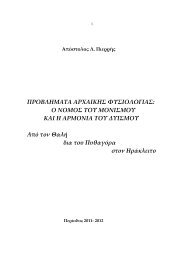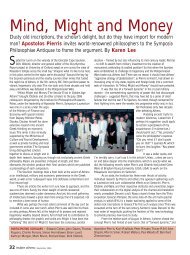APPENDIX C΄ ON DEPILATION: BODY COSMETICS IN CLASSICAL ...
APPENDIX C΄ ON DEPILATION: BODY COSMETICS IN CLASSICAL ...
APPENDIX C΄ ON DEPILATION: BODY COSMETICS IN CLASSICAL ...
You also want an ePaper? Increase the reach of your titles
YUMPU automatically turns print PDFs into web optimized ePapers that Google loves.
<strong>ON</strong> DEPILATI<strong>ON</strong>: <strong>BODY</strong> <strong>COSMETICS</strong> <strong>IN</strong> <strong>CLASSICAL</strong> ANTIQUITY 591<br />
ÎÂÊ·Ïɘ ô‰ËÏÔÓ. Cf. Photius p. 495.13 s.v. Û·‚‡ÙÙË˜Ø Í˘Ú‹Ûˆ˜<br />
Âr‰Ô˜. Given the razor work (͇ÚËÛȘ), it pobably referred to a style of<br />
tonsure, which Eupolis no doubt translated to a particular fashion of<br />
hair cosmetics in the pudendum area. And so Hesychius continues the<br />
explanation of Û¿‚˘ÙÙÔ˜: ÙÈÓb˜ ‰b Ùe Á˘Ó·ÈÎÂÖÔÓ (sc. ÌfiÚÈÔÓ or<br />
·å‰ÔÖÔÓ); cf. Photius ibid.; and Suda c110: Ùe Á˘Ó·ÈÎÂÖÔÓ ·å‰ÔÖÔÓ Ôî<br />
ΈÌÈÎÔd ηÏÔÜÛÈ... Û¿‚˘ÙÙÔÓ. For the plucking off the hair from the<br />
female triangle, cf. Lysistrata, 151: ‰¤ÏÙ· apple·Ú·ÙÂÙÈÏ̤ӷÈ. Cf. Ranae<br />
516: (çÚ¯ËÛÙÚ›‰Â˜) ì‚˘ÏÏÈáÛ·È ÎôÚÙÈ apple·Ú·ÙÂÙÈÏ̤ӷÈ). But then, it<br />
must mean here a kind of tonsure for the pubic hair (àappleÔÙÂÙÈÏ̤ӷ˜<br />
in slave-fashion ). In such a case it is very difficult to decide whether<br />
ηوӿ΢ as used in this way identifies the kind of tonsure as<br />
generally slave-like (i.e. one practiced by slave-girls; but then one could<br />
not very easily imagine a state of affairs where free-born women and<br />
slave-girls had different ways of arranging their pubic hair!); or perhaps<br />
as specially like that of the cloth ηوӿÎË; for one could even<br />
surmise a fashion according to which the hair was removed round the<br />
labia but for a circular band of hair left at some distance away from<br />
them; that could be reasonably taken to represent the main feature of<br />
οو-Ó¿ÎË. But however that may be, the interesting thing for our<br />
purpose is that, granting the correctness of the general standard<br />
interpretation of our passage, there was one at least particular way of<br />
tonsure for women’s pubic hair and, therefore, presumably other ways<br />
at least possible as well. In which case Baubo might have utilized some<br />
one such way in her exhibition to Demeter - or perhaps she might<br />
have invented a novel and strange way on purpose and with a definite<br />
intent and significance. But I do not think that we should here take<br />
Aristophanes too literally in a mechanical way; he rather plays here one<br />
of his exquisite games. The Scholia (or any other source) do not speak<br />
of any kind of tonsure called ηوӿ΢ or ηوӿÎË (as they do in<br />
Acharnenses, 849: KÚ·ÙÖÓÔ˜ àappleÔÎÂηṲ́ÓÔ˜ ÌÔȯeÓ ÌÈ÷Ä Ì·¯·›Ú÷·, to<br />
which the scholia remark: ÌÔȯe˜ ‰b Âr‰Ô˜ ηd ùÓÔÌ· ÎÔ˘ÚĘ àappleÚÂappleÔܘ,<br />
ÎÈÓ·È‰Ò‰Ô˘˜; even here there may be a play involved, cf.<br />
Hesychius s.v. ÎÉappleÔ˜). On the other hand we have other examples of<br />
such playful metaphors, misplacements or pregnant odd and<br />
unexpected combinations. Thus in Athenaeus, IX, 410c, we read: XÂÈ-<br />
ÚfiÌ·ÎÙÚÔÓ ‰b ηÏÂÖÙ·È ˇz Ùa˜ ¯ÂÖÚ·˜ àappleÂÌ¿ÙÙÔÓÙÔ èÌÔÏ›Óˇˆ. ÔÊÔ-<br />
ÎÏɘ OåÓÔÌ¿ˇˆ: ΢ıÈÛÙd ¯ÂÈÚfiÌ·ÎÙÚÔÓ âÎÎÂηṲ́ÓÔ˜ (Sophocles,










